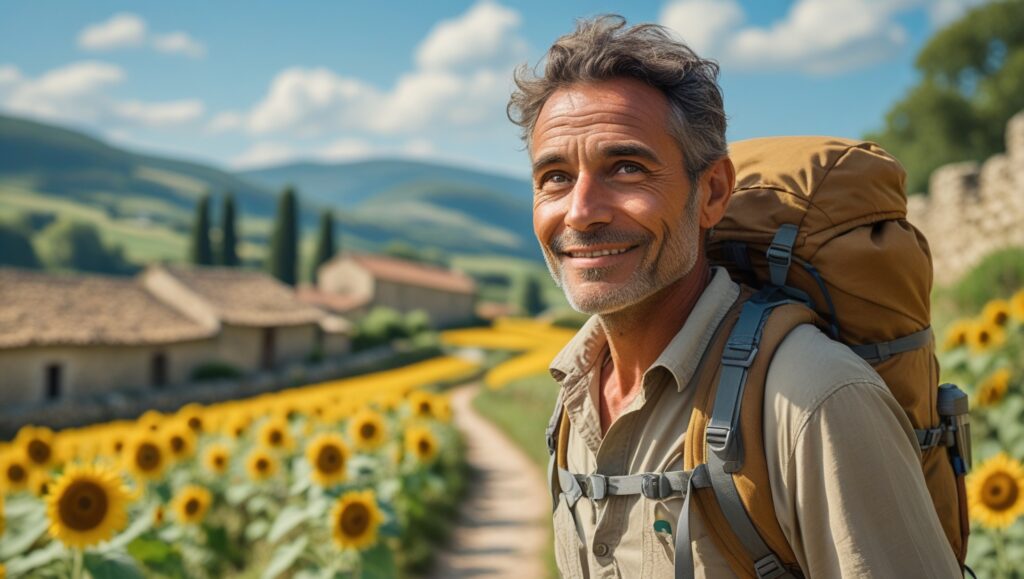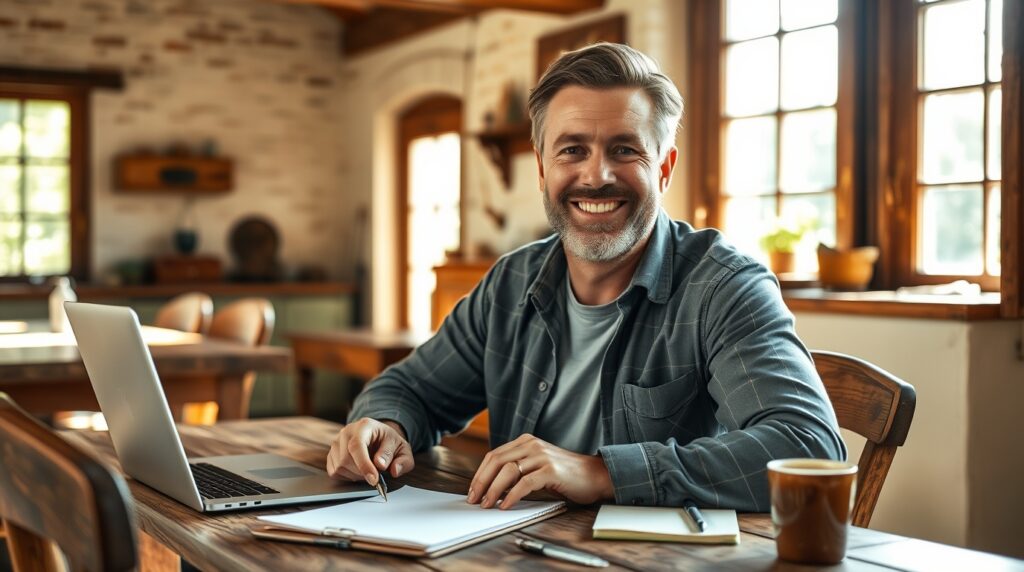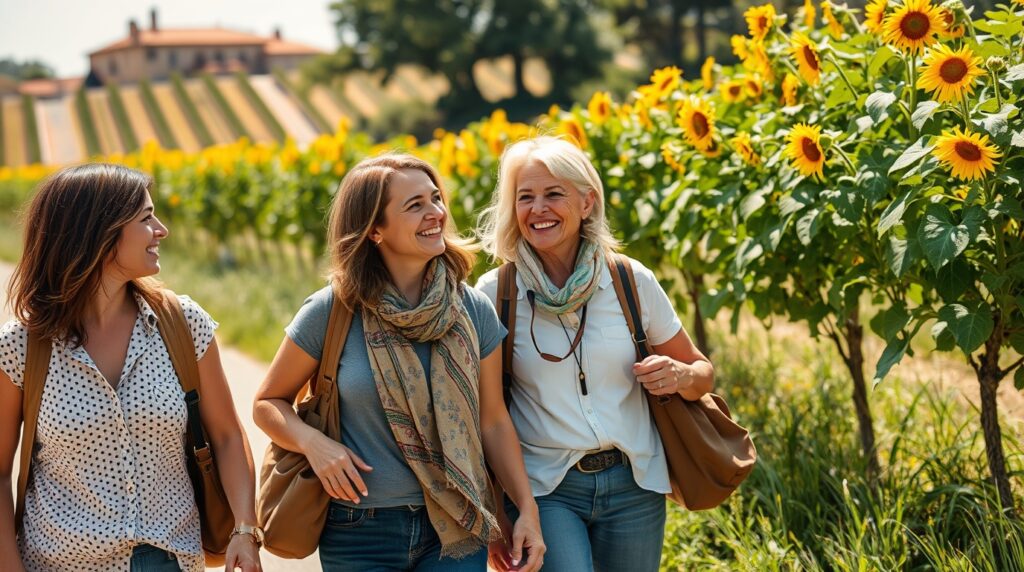It’s Not About Owning Less. It’s About Owning More Valuable Things
Summary: Forget everything you’ve been told about downsizing being about sacrifice and deprivation. This article challenges the mainstream narrative that smaller means lesser, revealing how strategic downsizing actually multiplies your wealth in ways that matter: time, energy, health and profound life satisfaction. Discover why Baby Boomers, Gen X, and older Millennials are secretly envying those who’ve made the bold move to downsize, and how finding your true purpose can liberate you from the possessions that possess you.
5 Key Takeaways:
- Downsizing is actually “upgrading” your life experience—more freedom, energy, and authentic living
- Purpose clarity eliminates the need for possession-based identity, freeing you from consumerist traps
- The “second act” of life begins when you stop accumulating and start experiencing
- Strategic downsizing creates wealth in experience, knowledge and understanding—the only currencies that matter in the long run
- Mental clarity increases naturally when environmental noise decreases—fewer possessions mean fewer decisions, leading to enhanced cognitive capacity for what truly matters
The real estate agent’s face fell when Jane told her she wanted to sell her 4,000-square-foot suburban palace to move into a 1,200-square-foot cottage. “But why would you want something so much smaller?” she asked, genuinely bewildered.
That question haunts our entire cultural conversation about downsizing. We’ve been conditioned to believe that less space equals less life, that fewer possessions mean fewer possibilities, that downsizing is what you do when you’ve given up on greatness.
Here’s the controversial truth: It’s not about less. It’s about more of the most precious things.
And the people who’ve figured this out? They’re not just living better lives—they’re ageing slower, thinking clearer, and experiencing a richness that makes their former supersized existence look like a black-and-white movie.
The Great Downsizing Deception
Society has sold us a narrative about downsizing that’s not just wrong—it’s backwards. We’re told it’s about:
- Making do with less
- Settling for smaller
- Accepting defeat in the acquisition stakes
- Preparing for decline
This narrative serves the consumer economy beautifully. It keeps us trapped in the hamster wheel of earning more to buy more to store more to maintain more. But it’s killing us—literally.
Research found that families living in cluttered homes had higher levels of cortisol (the stress hormone) throughout the day. Meanwhile, those same families spent only 40% of their leisure time actually relaxing in their living spaces—the rest was consumed by maintenance, organisation, and the mental load of managing their possessions.
The real downsizing story isn’t about subtraction. It’s about the multiplication of time, energy, experiences, and what researchers call “psychological wealth.”
The Purpose Pivot: When Clarity Creates Freedom
Here’s where most downsizing advice gets it wrong: it focuses on what to eliminate without addressing what to amplify. It’s like trying to lose weight by only thinking about what not to eat, rather than discovering what truly nourishes you.
The Purpose Pivot Protocol addresses this gap by helping you identify your authentic “second act”—not as a consolation prize for ageing, but as the main event you’ve been unconsciously preparing for your entire life.
Research by psychologist Dr. Patricia Boyle at Rush University Medical Centre followed over 900 older adults for up to seven years, finding that those with higher purpose in life were 2.4 times more likely to remain free of Alzheimer’s disease. Purpose, it turns out, isn’t just a philosophical luxury—it’s neurological necessity.
But here’s the catch: you can’t discover your authentic purpose while drowning in the noise of over-accumulation. As renowned minimalist architect Tadao Ando observed, “I believe that the way people live can be directed a little by the environment in which they live.” Your environment is either supporting your evolution or suffocating it.
When you downsize strategically—guided by purpose rather than driven by circumstances—something remarkable happens. The energy you once spent managing possessions gets redirected toward experiences that actually change you. The money you once allocated to maintenance gets invested in transformation. The mental space you once filled with consumer decisions gets occupied by creative possibilities.
The Second Act Advantage: Why Your Best Years Are Ahead
Current culture has it backwards about ageing. We act as if life peaks at 30 and it’s all decline management from there. But developmental psychology tells a different story.
Dr. Erik Erikson’s research on life stages identified the period from roughly 40-65 as “generativity vs. stagnation”—the time when humans naturally shift from self-focused achievement to contribution-focused fulfilment. This isn’t consolation for lost youth; it’s evolution toward wisdom.
The catch? This natural transition gets hijacked by possessions that anchor you to your first-act identity. Your house becomes a museum of who you used to be. Your closet becomes a mausoleum of former aspirations. Your garage becomes a graveyard of abandoned hobbies.
Strategic downsizing doesn’t eliminate your past—it liberates your future.
As people age, they naturally become better at “socioemotional selectivity”—prioritising experiences and relationships that provide meaning over those that provide novelty. This isn’t diminishment; it’s optimisation.
The problem is that our living situations often work against this natural wisdom, keeping us trapped in patterns that served us at 35 but sabotage us at 55.
The Wealth Paradox: How Less Becomes More
Here’s the math that the real estate industry doesn’t want you to calculate:
Traditional “Wealth” Equation:
- Larger home = Higher mortgage/taxes/insurance/maintenance
- More possessions = More storage/organisation/replacement costs
- Longer commutes (for affordable, larger homes) = More time and fuel costs
- Higher overhead = More time working to maintain lifestyle
- Result: Time poverty despite financial accumulation
Downsized “Wealth” Equation:
- Smaller home = Reduced fixed costs
- Fewer possessions = Minimal maintenance obligations
- Intentional location = Reduced transportation costs
- Lower overhead = More time for experiences and relationships
- Result: Time abundance with financial flexibility
But the real wealth multiplication happens in categories that don’t appear on any financial statement:
Health Wealth: Reduced stress, more time for exercise, better sleep quality, improved nutrition (smaller kitchens encourage fresh cooking over processed storage)
Social Wealth: Deeper relationships (energy no longer consumed by property management), stronger community connections (smaller spaces encourage getting out more)
Creative Wealth: Mental space for exploration, time for learning, resources for experiences rather than acquisitions
Spiritual Wealth: Alignment between values and lifestyle, reduced cognitive dissonance, authentic self-expression
Science Supports Simplicity
The academic research on downsizing and life satisfaction has reached a tipping point. Studies consistently show that, beyond meeting basic needs, additional possessions provide diminishing returns on happiness while creating exponential increases in stress.
People who prioritise materialistic values report lower well-being, more anxiety, and weaker social connections than those who prioritise intrinsic values like personal growth and relationships. His longitudinal studies show these effects compound over time, meaning the pursuit of more stuff doesn’t just fail to deliver happiness, it actively undermines it.
Meanwhile, “experiential purchases” (travel, education, nature experiences) shows the opposite pattern: satisfaction increases over time as memories integrate into identity and relationships.
My Camino walking retreat represents the perfect synthesis of these research insights—combining nature immersion, physical activity, social connection, and experiential richness while requiring minimal possessions.
Especially my Nature Immersion Stress Relief retreat.
While Silicon Valley billionaires spend fortunes on experimental longevity treatments, there’s a free anti-ageing elixir hiding in plain sight: deep nature immersion. And here’s where downsizing becomes not just smart, but transformational.
Just 15 minutes in nature can reduce cortisol levels by 16%, blood pressure by 2%, and sympathetic nerve activity by 4%. But these are just the measurable effects. The unmeasurable ones—the sense of perspective, the creative clarity, the spiritual reset—these are where the real magic happens.
This is why my Camino walking retreat represents something revolutionary in how we think about the second half of life. It’s not a vacation from your real life—it’s a laboratory for discovering what your real life could actually be.
Picture this: You’re walking ancient paths through the French countryside, carrying everything you need in a single backpack. No mortgage stress following you via smartphone notifications. No weekend plans hijacked by home maintenance emergencies. No mental energy drained by decisions about which of your 47 coffee mugs to use.
Instead, you have something our ancestors took for granted but we’ve forgotten how to access: uninterrupted communion with natural rhythms. Your body syncs with sunrise and sunset. Your mind clears with each footstep. Your priorities reorganise themselves without your conscious effort.
This isn’t romantic idealisation—it’s neuroplasticity in action. Nature immersion rewires the brain, reducing activity in the subgenual prefrontal cortex (the area associated with rumination and depression) while increasing activity in areas linked to creativity and problem-solving.
The Freedom Formula: Purpose + Place + Practice
The most successful downsizers—those who thrive rather than just survive the transition—follow what I call the Freedom Formula:
Purpose: Clear understanding of your values and direction (developed through protocols like the Purpose Pivot)
Place: Intentional selection of an environment that supports rather than distracts from your purpose
Practice: Regular engagement with activities that reinforce your values and direction
The Camino experience provides intensive immersion in all three elements, creating what researchers call “implementation intentions”—specific plans for how you’ll maintain insights after returning to regular life.
The Critics Are Missing the Point
Critics of downsizing often focus on economic arguments: “You’re just encouraging people to be less productive!” or “Someone has to buy the big houses and luxury goods!”
They’re missing the revolutionary implications. When people downsize strategically, they don’t become less productive—they become more selectively productive. Instead of working harder to afford more stuff, they work smarter to afford more freedom.
This isn’t about everyone living in tiny houses or walking ancient French trails (though both experiences can be transformational). It’s about questioning the automatic equation of more with better, and discovering what “enough” actually feels like in your own life.
Your Second Act Starts Now
The downsizing conversation has been hijacked by circumstances—divorce, financial necessity, health crises. But the most powerful downsizing is proactive, not reactive. It’s driven by vision, not crisis.
The question isn’t whether you can afford to downsize. The question is whether you can afford not to.
Every day you spend maintaining possessions that don’t serve your purpose is a day stolen from your second act. Every dollar you allocate to storage and maintenance is a dollar not invested in transformation. Every mental cycle you waste on consumer decisions is energy not available for creative possibility.
The baby boomers, Gen X, and older millennials who’ve figured this out aren’t just living differently—they’re ageing differently. They have what researchers call “psychological richness”—lives characterised by interesting experiences, emotional complexity, and continuous growth.
They’re the ones booking Camino walking retreats not as escapes from their lives, but as laboratories for their lives. They’re the ones discovering that their best years aren’t behind them—they’re just beginning.
Because when you’re no longer weighed down by possessions that possess you, when your environment supports rather than distracts from your evolution, when your energy goes toward experiences rather than acquisitions, something magical happens:
5 Frequently Asked Questions
Q: Isn’t downsizing just giving up on success and ambition? A: Strategic downsizing isn’t about giving up on success—it’s about redefining it. Psychological well-being in later life depends more on personal growth, purpose, and autonomy than on material accumulation. Downsizing aligned with purpose often increases rather than decreases life satisfaction and achievement in meaningful areas.
Q: How do I know if I’m ready for a major lifestyle change like downsizing? A: Ready-ness isn’t a feeling—it’s a decision followed by action. However, common indicators include: spending more time maintaining possessions than enjoying them, feeling drained by your environment rather than energised, having unclear priorities due to too many options, or experiencing what psychologists call “decision fatigue” from managing complexity. The Purpose Pivot Protocol can help clarify whether downsizing aligns with your authentic values.
Q: What if I downsize and regret it? A: Research on “buyer’s remorse” versus “experiential satisfaction” shows that people rarely regret experiences, while they frequently regret purchases. Downsizing is fundamentally about shifting from possessions to experiences. Most downsizers report that their only regret is not doing it sooner. The key is strategic downsizing guided by purpose rather than reactive downsizing driven by crisis.
Q: How does nature immersion specifically help with ageing and life transitions? A: Nature exposure reduces stress hormones, improves immune function, and enhances cognitive performance. The Japanese practice of “forest bathing” (shinrin-yoku) has been shown to increase natural killer cells (part of the immune system) by 50% after just three days in nature. For people in life transitions, nature provides what psychologists call “restoration attention theory”—the mental reset needed for making clear decisions about life direction.
Q: Is downsizing practical for people with families or complex financial situations? A: Downsizing can be adapted to virtually any situation. The key is focusing on principles rather than prescriptions. Financially, downsizing often improves rather than compromises security by reducing fixed costs and increasing flexibility. The goal isn’t minimalism for its own sake, but intentionality that serves your family’s authentic values and long-term well-being.
Research
UCLA Study on Cluttered Homes and Cortisol
The UCLA Centre on Everyday Lives of Families (CELF) conducted a study examining the impact of clutter on stress, specifically measuring diurnal cortisol levels—a biomarker for stress—via saliva samples from families. The research found a significant link between the density of household objects (clutter) and elevated cortisol levels, particularly among women. The study noted that women who described their homes as cluttered or disorganised exhibited higher cortisol levels, suggesting that clutter is associated with chronic stress. The mental and physical effects of clutter were found to be more pronounced in women than in men.
Dr. Yoshifumi Miyazaki’s Nature Immersion Statistics
Dr. Yoshifumi Miyazaki of Chiba University is recognised as a leading researcher in the field of forest bathing (shinrin-yoku) and its health benefits. Miyazaki has authored 47 articles with 2,208 citations, focusing on the positive effects of forest bathing on mental health, including reductions in depression, anxiety, and stress. While the specific statistics from Miyazaki’s studies are not detailed in the provided sources, his work consistently demonstrates that immersion in forest environments leads to measurable improvements in psychological well-being and physiological markers of stress.
Stanford Nature and Health Research Lab Findings
The Stanford Nature and Health Research Lab, notably through research led by Gregory Bratman and colleagues, found that walking in nature provides measurable mental health benefits. Their studies demonstrated that time spent in natural environments can reduce rumination (repetitive negative thinking), lower activity in the subgenual prefrontal cortex (a brain region linked to depression), and improve mood and aspects of cognitive function, such as working memory. These findings suggest that exposure to nature may help reduce the risk of depression and support emotion regulation.
Dr. Patricia Boyle’s Alzheimer’s Prevention Study
Dr. Patricia Boyle, as part of the Rush Memory and Ageing Project, conducted a longitudinal study involving 246 older adults to examine the relationship between purpose in life and Alzheimer’s disease (AD). The study found that a higher sense of purpose in life was associated with a substantially reduced risk of developing AD, mild cognitive impairment, disability, and death. Importantly, purpose in life appeared to buffer the negative effects of AD pathological changes (such as amyloid plaques and neurofibrillary tangles) on cognitive function and slowed cognitive decline, even after adjusting for potential confounders. The protective effect was observed both in cross-sectional and longitudinal analyses.









Stress destroys Lives. To find out what you can do to safeguard your sanity by taking my insight-giving quiz, subscribe to my mailing list.

“I am an experienced medical doctor – MBChB, MRCGP, NLP master pract cert, Transformational Life Coach (dip.) Life Story Coach (cert.) Stress Counselling (cert.) Med Hypnotherapy (dip.) and EAGALA (cert.) I may have an impressive number of letters after my name, and more than three decades of professional experience, but what qualifies me to excel at what I do is my intuitive understanding of my clients’ difficulties and my extensive personal experience of managing major life changes using strategies I developed over many years.” Dr M Montagu
Having a purpose is of such primordial importance to me, that I have created two “Define Your Life Purpose” Mentoring Programs: The Purpuse Pursuit Protocol is for you if you are still searching for your life purpose, and the Purpose Pivot Protocol – perfect if you have a life purpose that needs adjusting.

